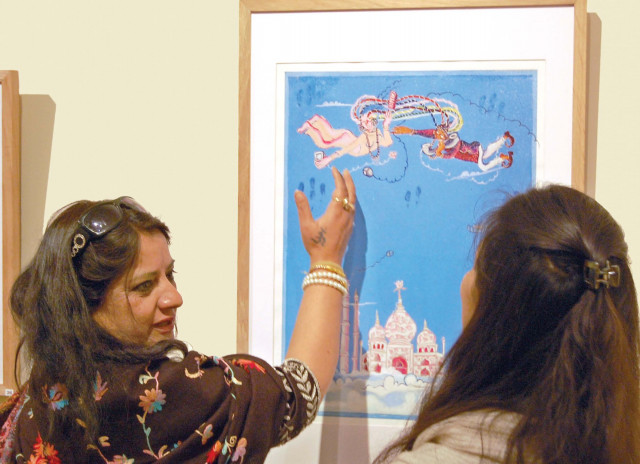Ragini sings through her art
Ragini Upadhyay Grela is a contemporary artist, continuously evolving to add creative aesthetic to her work.

Keeping in line with his thought, Ragini Upadhyay Grela is one contemporary artist, continuously growing and evolving to add creative aesthetic to her work. After being in the business for almost 32 years with 70 odd exhibitions under her belt, Upadhyay’s work is housed by royalty in Nepal and India, along with private and commercial collectors around the globe.
“The energy that South Asian women possess is fantastic and that is what Ragini captures in essence in her work,” said Arjumand, owner of Gallery 6. “There is a new imagery every time and that is the sign of a creative mind and a true artist,” she added.
Ragini stands by strict creative ethics to keep evolving as an artist and her current collection on display in Gallery 6 is a testament to surrealistic art at its peak. Having started her career as a painter, the artist went on to get training in print-making from the UK, Germany and India.
Heavily inspired by Dali, Van Gogh and Segal, the artist is a master of surrealism and controversy. ‘Love in the Air-Saraswati’ is one acclaimed piece that raised many eyebrows throughout the Hindu world. This controversial piece depicting Goddess Saraswati with a computer monitor on her head and a cell phone in hand, got Grela threat calls from Hindu extremists.
Through her collection ‘Love in the Air’, the artist talks about the world becoming a smaller place due to the expanding use of the airwaves in the form of technological advancements. Projection of such ideas has taken the artist to many monumental sites around the globe as she connects the Eifel Tower to Nepalese culture through the use of symbolism.
In an interview with The Express Tribune, Grela talked about her worst fears and her favourite collector and vacation spots.
“My worst fear is that my work will not have a house before I die,” said Grela. “I want to find each piece of my work a suitable home as they are my children and would hate to see them go to waste.”
As modern art in the subcontinent takes a turn for commercialism the artist voices her disapproval. “The moment artists take inspiration from the commercial aspect of art is the day their creative side dies,” she said.
“Picasso and Dali never thought how much their work would sell for and painted what they felt,” added the artist. A fan of Jamil Naqsh and Chugtai, Grela is also a Rabia Zuberi collector.
The use of symbolism in Grela’s work is fantastic and one can stand in front of one piece alone for hours at end, deriving various meanings from a single symbol.
While the telephone receiver depicts connectivity and love, the serpent symbolises human desire. The use of the serpent in Grela’s work is twofold. Where used with caution a serpent can be beneficial, while at its peak, the malice depicted by the serpent is equivalent to the energy destroying nations.
Grela finds inspiration for her work in “every existing moment of her life.” The collection is a must-see and truly a collector’s item worthy of royalty.
While the collection on show at Gallery 6 does not consist of the original pieces, the artist has brushed over the digital screen print with acrylics to give them a more authentic touch. While each of these prints sell in Sweden for 600 Euros a piece, the artist has subsidized her collection in Pakistan to Rs35,000 to 40,000 per print.
Published in The Express Tribune, February 24th, 2011.



















COMMENTS
Comments are moderated and generally will be posted if they are on-topic and not abusive.
For more information, please see our Comments FAQ